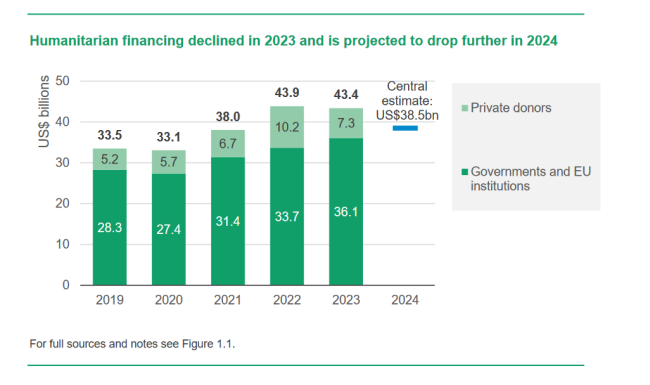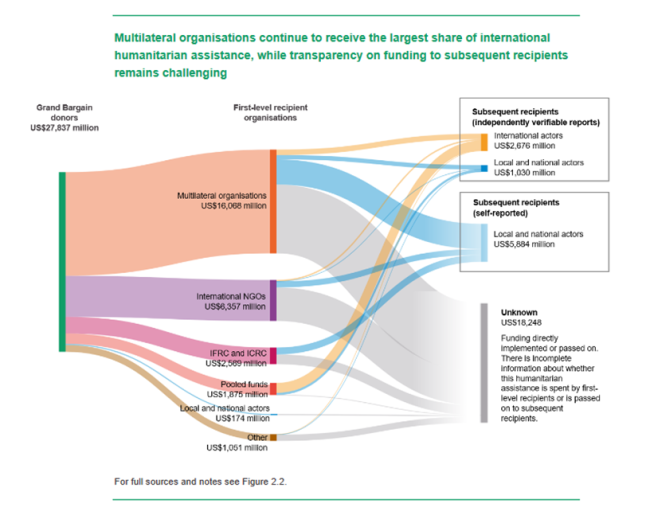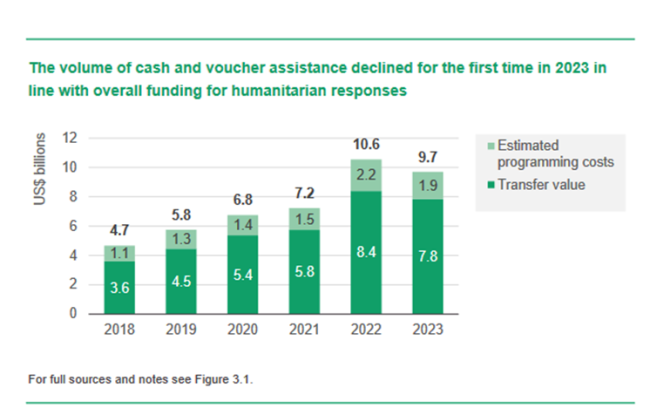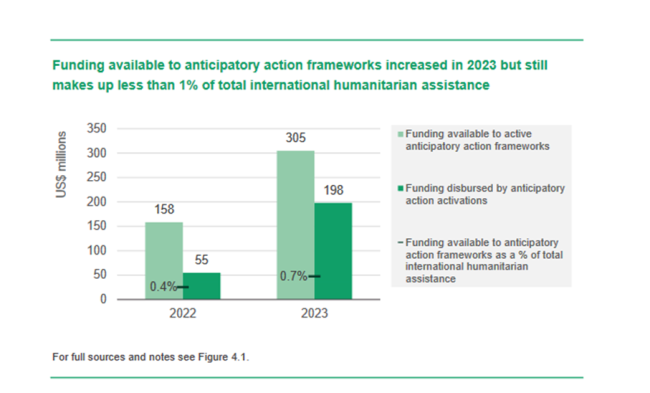Highlights:
Overview
Funding to the humanitarian sector stalled in 2023, failing to keep pace with rising demand. While international humanitarian assistance remained historically high at over US$43 billion, interagency appeals faced a funding gap of US$32 billion, the largest on record. Ultimately, humanitarian funding and reform efforts fell short, and many millions of people targeted by international humanitarian responses did not receive the support they needed. With key donors and organisations across the sector making budget cuts, Development Initiatives’ (DI’s) projections indicate that funding will fall further in 2024.

In 2022, most of the largest humanitarian donors increased their contributions in response to the Ukraine crisis, but the picture in 2023 was mixed. Several made significant cuts, including the UK, Germany and Canada. While these were mostly offset by increases from other donors such as Japan and Norway, the donor base continued to narrow, with a small number of donors providing the vast majority of funding. Taken together with the overall funding decrease and reports that major donors are planning further cuts, this underlines the fragility of a system already under strain.
International humanitarian assistance continued to focus on protracted crises, part of a significant shift over the last decade. In 2014, only 29% of funding required for interagency appeals was for protracted crises, but in 2024 this had reached 91%. This should spur more coherent action across the humanitarian–development–peace nexus to address the underlying drivers of crises. It also reinforces the importance of Grand Bargain commitments to increase multi-year funding and planning.
Funding to local and national actors
Some progress was made in 2023 across several key areas in this regard. Despite the longstanding Grand Bargain commitment to provide an aggregate of at least 25% of funding to local and national actors as directly as possible, Grand Bargain signatories only provided 4.4% of their total funding to local and national actors in 2023, and only provided 0.6% directly (based on independently verifiable data). Taking into account self-reported, global aggregates by Grand Bargain intermediaries – which are not possible to verify independently – this figure rises to 25%. Across the broader humanitarian system, direct funding for local and national actors increased from 2.3% to 4.5% of all trackable funding, but this was due to new allocations by two specific non-Grand Bargain donors.

Cash and voucher assistance
The adoption of humanitarian cash and voucher assistance (CVA) has grown significantly over the last decade, but 2023 data suggests that this growth could be stalling. Growth has been driven by donors and implementers alike, who largely agree it can be a more cost-efficient way to deliver assistance than other delivery modalities, and that cash provides choice and dignity to affected populations. The volume of humanitarian CVA declined for the first time in 2023 after years of growth in line with a decline in overall funding, but it grew slightly as a share of overall international humanitarian assistance.

Anticipatory action and other pre-arranged financing mechanisms
Past research has shown that between 2014 and 2017 around a fifth of humanitarian responses were due to crises that could have been anticipated. Despite this, anticipatory action remains an underused humanitarian response modality. It can prevent and mitigate acute humanitarian impacts for predictable hazards more effectively than reactive responses, saving lives, livelihoods and money in the longer term. Funding for anticipatory action frameworks increased in 2023 but stood at less than 1% of total international humanitarian assistance, a fraction of what is needed. This should spur more coherent action across the humanitarian–development–peace nexus to address the underlying drivers of crises.

| Publisher | Development Initiatives |
| Geographic coverage | Global |
| Originally published | 26 Nov 2024 |
| Knowledge service | Metadata | Global Food and Nutrition Security | Needs assessment |
| Digital Europa Thesaurus (DET) | humanitarian aidaid systemMonitoringaid policyfood aid |
